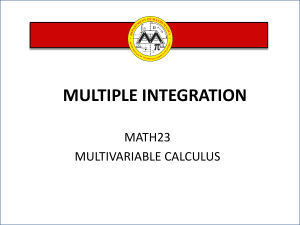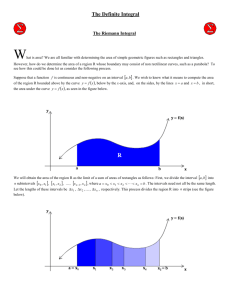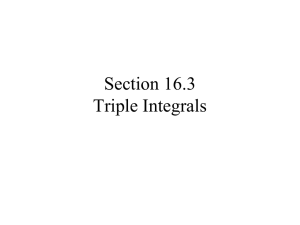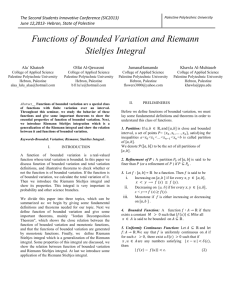Topics in integration
advertisement
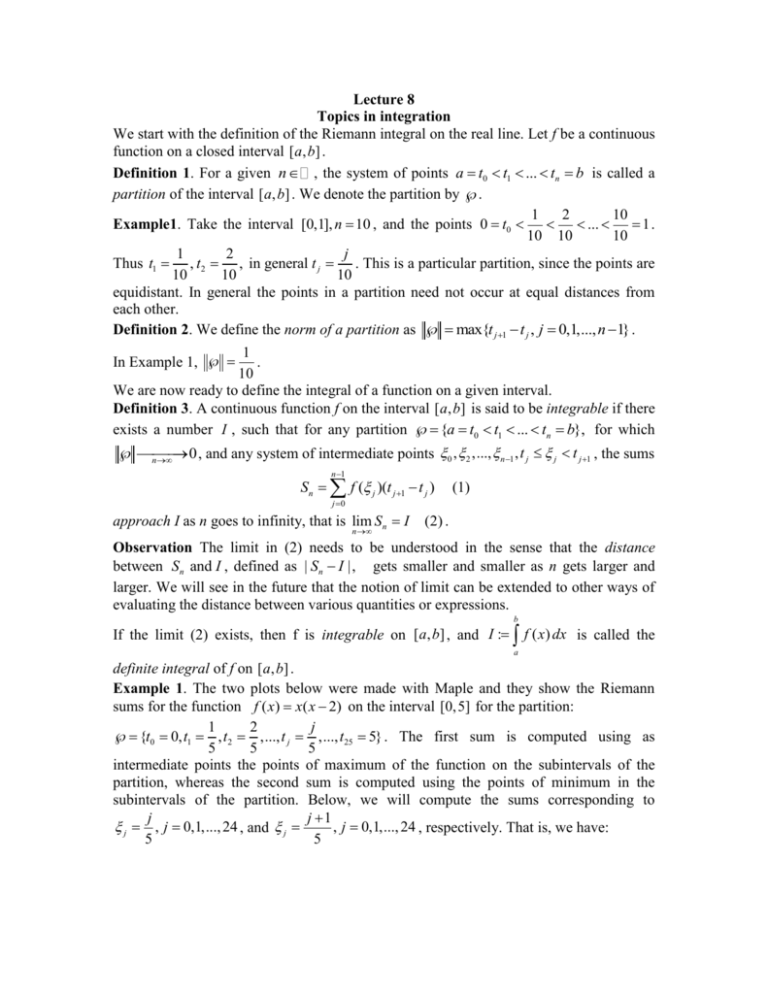
Lecture 8
Topics in integration
We start with the definition of the Riemann integral on the real line. Let f be a continuous
function on a closed interval [a, b] .
Definition 1. For a given n , the system of points a t0 t1 ... tn b is called a
partition of the interval [a, b] . We denote the partition by .
1
2
10
Example1. Take the interval [0,1], n 10 , and the points 0 t0 ... 1 .
10 10
10
1
2
j
Thus t1 , t2 , in general t j . This is a particular partition, since the points are
10
10
10
equidistant. In general the points in a partition need not occur at equal distances from
each other.
Definition 2. We define the norm of a partition as max{t j 1 t j , j 0,1,..., n 1} .
1
.
10
We are now ready to define the integral of a function on a given interval.
Definition 3. A continuous function f on the interval [a, b] is said to be integrable if there
exists a number I , such that for any partition {a t0 t1 ... tn b}, for which
In Example 1,
0 , and any system of intermediate points 0 , 2 ,..., n 1 , t j j t j 1 , the sums
n
n 1
Sn f ( j )(t j 1 t j )
(1)
j 0
approach I as n goes to infinity, that is lim Sn I
n
(2) .
Observation The limit in (2) needs to be understood in the sense that the distance
between Sn and I , defined as | Sn I | , gets smaller and smaller as n gets larger and
larger. We will see in the future that the notion of limit can be extended to other ways of
evaluating the distance between various quantities or expressions.
b
If the limit (2) exists, then f is integrable on [a, b] , and I : f ( x) dx is called the
a
definite integral of f on [a, b] .
Example 1. The two plots below were made with Maple and they show the Riemann
sums for the function f ( x) x( x 2) on the interval [0, 5] for the partition:
1
2
j
{t0 0, t1 , t2 ,..., t j ,..., t25 5} . The first sum is computed using as
5
5
5
intermediate points the points of maximum of the function on the subintervals of the
partition, whereas the second sum is computed using the points of minimum in the
subintervals of the partition. Below, we will compute the sums corresponding to
j
j 1
j , j 0,1,..., 24 , and j
, j 0,1,..., 24 , respectively. That is, we have:
5
5
24
S
(1)
25
j 0
24
j 1 24 j j
1 24 25 49 2 24 25
f ( ) 2
15.2,
5 5 j 0 5 5
6 53
2 52
5
(2)
S25
f(
j 0
j 1 1 24 j 1 j 1 1 25 26 51 2 25 26
)
2
18.2.
5 5 j 0 5 5
6 53
2 52
5
As it is known, the exact area under the graph is given by
5
5
x3
125
50
2 5
f
(
x
)
dx
x
(
x
2)
dx
25 .
x 0
0
0
3
3
3
An extension of the Riemann integral is given by an integral of the form:
f ( x) dg ( x) (3). When g is a differentiable function the above integral is nothing but
f ( x) g '( x)dx , so it reduces to a Riemann integral. However, the integral in (3) can be
defined for a larger class of functions, g, namely functions that have bounded variation.
Definition 2. A function g :[a, b]
has bounded variation if there exists a real
number M, such that for any partition {a t0 t1 ... tn b} of the interval [a, b] ,
n 1
g (t
j 0
j 1
) g (t j ) M .
If f is continuous and g has bounded variation on [a, b] , we define
f ( x) dg ( x) as
n 1
lim f ( j ) g (t j 1 ) g (t j ) , where t j j t j 1 .
n
j 0
Here are some results concerning functions that have bounded variation, to get a better
idea of their behavior. First, we give one more definition.
Definition 3. A function g :[a, b] is monotone if it is either increasing or decreasing
on the interval [a, b] , that is either g ( s) g (t ) whenever s t , or g ( s ) g (t ) whenever
s t , respectively.
Theorem 1. A monotone function on an interval [a, b] has bounded variation.
Proof. Let us assume that g is increasing. The case when g is decreasing can be proved in
a similar manner. For any partition {a t0 t1 ... tn b} we have
n 1
g (t
j 0
n 1
j 1
) g (t j ) g (t j 1 ) g (t j ) g (b) g (a),
j 0
since g (t j 1 ) g (t j ), for all j 0,1..., n -1 .
QED
Theorem 2. If g :[a, b] is differentiable and has a bounded derivative, that is there
exists a constant c such that | g '(t ) | c, for all t [a, b] , then g has bounded variation.
Proof. Consider an arbitrary partition of the interval [a, b]: {a t0 t1 ... tn b} .
From the mean value theorem we have that for any j there exists j [t j , t j 1 ] such that
g (t j 1 ) g (t j ) g '( j ) t j 1 t j . Therefore
n 1
g (t
j 0
n 1
n 1
j 0
j 0
j 1 ) g (t j ) g '( j )(t j 1 t j ) g '( j ) (t j 1 t j )
n 1
c (t j 1 t j ) c(b a),
j 0
and therefore g has bounded variation.
QED
The next theorem provides a complete characterization of functions that have bounded
variation. We state it without proof.
Theorem 3. A function g :[a, b]
has bounded variation if and only if it is the
difference of two monotone non-decreasing functions on [a, b] .
We now move on to the construction of a new type of integral, of the form
T
f (t , )dB(t, ),
(4)
0
where B(t , ) is a standard Brownian motion. Such an integral is called Itô stochastic
integral.
First, here is a rationale for considering such an object.
Example 2. Consider the simple population growth model, which applies to the behavior
of a bank account. If N (t ) is the amount held in the account at time t, and the amount
grows at a rate which is proportional to the amount itself, then we can model this
behavior by the equation:
dN (t )
rN (t ) (5)
dt
In the equation (5) we assume that r is constant, but r can be as well considered as
depending on t.
N '(t )
r , and
Now, in order to solve in (4) for N (t ) we rewrite the equation as:
N (t )
integration with respect to t gives:
(ln N (t )) ' dt rdt , or ln( N (t )) rt c (6)
If the amount at time t 0 is known, N0 N (0) , then the solution (6) can be written as
N (t ) N 0e r t .
If in equation (5) the rate at which the account grows is not completely known, but is
subject to some random environmental effects, we may have r " noise " , where we
do not know the exact behavior of the noise term but only its probability distribution. The
dN (t )
( " noise ") N (t ) (6) ?
question is how do we solve the new equation
dt
It turns out that a good model for the noise term is provided by the Brownian motion. In
attempting to solve equation (6) we need the definition of the new type of integral
introduced in (4).
We proceed to defining (4) following the model we had for the Stieltjes integral, that is
we would like to be able to estimate the integral in (4) by sums of the form
n 1
f ( , ) B(t
j 0
j
j 1
, ) B(t j , ) (7) ,
where as usual, {0 t0 t1 ... tn T } is a partition of the interval [0, T ] , and
t j j t j 1 .
Observation The sum defined in (7) is a random variable.
Unfortunately, there are two problems that arise up-front:
Problem 1. In the construction of the Riemann integral, as in the Stieltjes integral, the
choice of the intermediate points t j j t j 1 does not affect the convergence of the sum
to the desired integral. However, it does in the new construction, as the following
example will show.
Example 3. Let us consider f (t , ) B(t , ) , the Brownian motion itself, and the
following two sums, corresponding to j t j , and j t j 1 , respectively. We have:
n 1
S1 B(t j , ) B(t j 1 , ) B(t j , ) , and
j 0
n 1
S2 B(t j 1 , ) B(t j 1 , ) B(t j , )
(8)
j 0
We now compute
n 1
E ( S1 ) E B(t j , ) B(t j 1 , ) B(t j , )
j 0
n 1
E B(t j , ) E B(t j 1 , ) B(t j , ) (using the independence of the increments)
j 0
0
Before we compute E ( S 2 ) , we need a preliminary result regarding the Brownian motion.
In particular, the following result gives the covariance of two different positions on the
Brownian paths.
Theorem 4. Let 0 s t . Then E Bs Bt s .
Proof. We have
E Bs Bt E Bs ( Bt Bs ) Bs2 E Bs E Bt Bs E ( Bs2 )
E ( Bs2 ) s
QED
Using Theorem 4 we may evaluate
n 1
E ( S 2 ) E B (t j 1 , ) B (t j 1 , ) B (t j , )
j 0
n 1
E B 2 (t j 1 , ) E B (t j 1 , ) B (t j , )
j 0
n 1
t j 1 t j tn t0 T .
j 0
Therefore, since E (S1 ) 0 and E ( S2 ) T , the two sums considered in (8) will lead to
different objects.
In order to deal with this problem, we will only consider the sums as defined by S1 .
Problem 2. In order to define the Stieltjes integral, we needed the function g to have
bounded variation, but the paths of the Brownian motion do not have bounded variation.
However, the Brownian motion paths have finite quadratic variation.
Definition 4. The quadratic variation of the Brownian paths is defined as
n 1
sup ( Bt
j 0
j 1
Bt j ) 2 ,
where the supremum is taken over all partitions {0 t0 t1 ... tn T } with
0.
n
We have the following powerful result (that we give without proof) concerning the
quadratic variation of the Brownian motion.
Theorem 5. Let Bt , t 0 be the standard Brownian motion. For every fixed T
n 1
lim Bt j1 ( ) Bt j ( )
n
j 0
2
T
for almost all .
Observation The meaning of “for almost all ” in the Theorem 5 is that if there are
paths (that is ’s) for which the convergence does not hold, then the set of such paths
has probability zero.
We will prove a less powerful result regarding the quadratic variation of the Brownian
motion.
Theorem 6. Let Bt , t 0 be the standard Brownian motion. For every fixed T
n 1
E Bt j1 ( ) Bt j ( )
j 0
T
2
Proof We have
n 1
E Bt j1 ( ) Bt j ( )
j 0
E B
2
n 1
t j 1
j 0
( ) Bt j ( )
V B
2
n 1
j 0
t j 1
( ) Bt j ( )
n 1
(t j 1 t j ) T
j 0
QED
EXERCISES
1. Write the Riemann sum corresponding to the function f ( x) x on the interval [0, 2] ,
a partition with 8 intervals ( n 8 ), and intermediate points being the left end-point of
each subinterval. Compare the value of the sum with the exact value of the integral
2
f ( x)dx
0
2. Repeat Problem 1 for the intermediate points being the right end-point of each
subinterval.
3. Find the Riemann sum corresponding to the function f ( x) x on the interval [0, 2] ,
a partition with 2n intervals and intermediate points being the left end-point of each
subinterval. Find how big should n be chosen such that the sum you found
approximates the correct value of the integral with an error less than 102 .
4. Repeat problem 3 for the intermediate points being the right end-point of each
subinterval.
5. Let f ( x) x , g ( x) x 2 on the interval [0,1] . Check that
1
0
1
f ( x)dg ( x) f ( x) g '( x)dx
0
In order to do so you must evaluate the integral on the right side of the equality, and
compare it with the estimates obtained for the integral on the left using the definition of
the Stieltjes integral.
Hint: To estimate the Stieltjes integral use sums of the form
n 1
j j 1
j
f ( ) g(
) g( )
n
n
n
j 0



